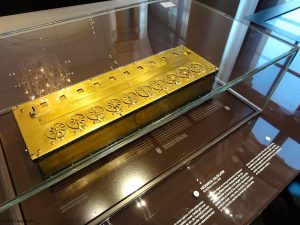Mathematisch-Physikalischer Salon, Dresden
Of the many museums in Dresden, one was recommended to us more than once: the Mathematisch-Physikalischer Salon in the Zwinger complex of the old town. We’d seen the signs advertising the exhibition several times as we passed the dark walls of the Zwinger, but it wasn’t until quite late in our visit that we managed to enter the museum.
Entrance is €6, but is covered by the two-day Dresden-City-Card; holders of the one-day card get a discount. Audio guides are available for €3, but we didn’t notice this immediately as we were met at the door by a member of staff, who checked our tickets, gave us stickers to wear, directed us to the lockers to store our bag, then pointed us in the direction of the first exhibition.
The museum comprises four rooms: the Langgalerie, the Bogengalerie and the Neuer Saal on the lower floor and the Festsaal on the upper level. Each of the rooms focuses on a different theme, and contains an impressive collection of instruments. The long gallery was particularly interesting with its astrolabes, compasses, automatons and other items — it was fascinating to see how advanced technology was 400 years ago. The display of weights and balances with an original German mark weight (the equivalent of a pound weight) was a highlight for me.
In the Bogengalerie the focus is on clocks; a video next to an open model of a pendulum clock explains both the mechanism and why clocks tick — so if you’ve ever wondered, here’s your chance to find out. One of Blaise Pascal’s mechanical calculators is also on display, accompanied by an interactive touchscreen display in English and German which explains its history and how it functions.

Upstairs in the Festsaal, you’re greeted by an array of burning mirrors, whose function is explained by signs in German and English as well as on a video display. In fact, explanations throughout the whole museum are clearly written in both languages, and several video displays show the operation of one or more instruments using computer-generated images. A large touchscreen at the back of the Neuer Saal invites you to interact with old data — from 1828 the Mathematisch-Physikalischer Salon has functioned as a weather station, with a variety of measurements being taken and carefully recorded. You can explore the data recorded for fifty years from 1828, and compare digital graphs of the information with current temperatures.
Although an hour is more than enough time to see the Mathematisch-Physikalischer Salon, it’s certainly worth a visit — particularly if you’re interested in measuring apparatuses.
[box]The Mathematisch-Physikalischer Salon costs €6, or for €10 you get access to the three Zwinger museums. Entrance is included with Dresden-Cards that are valid for two or more days. [/box]